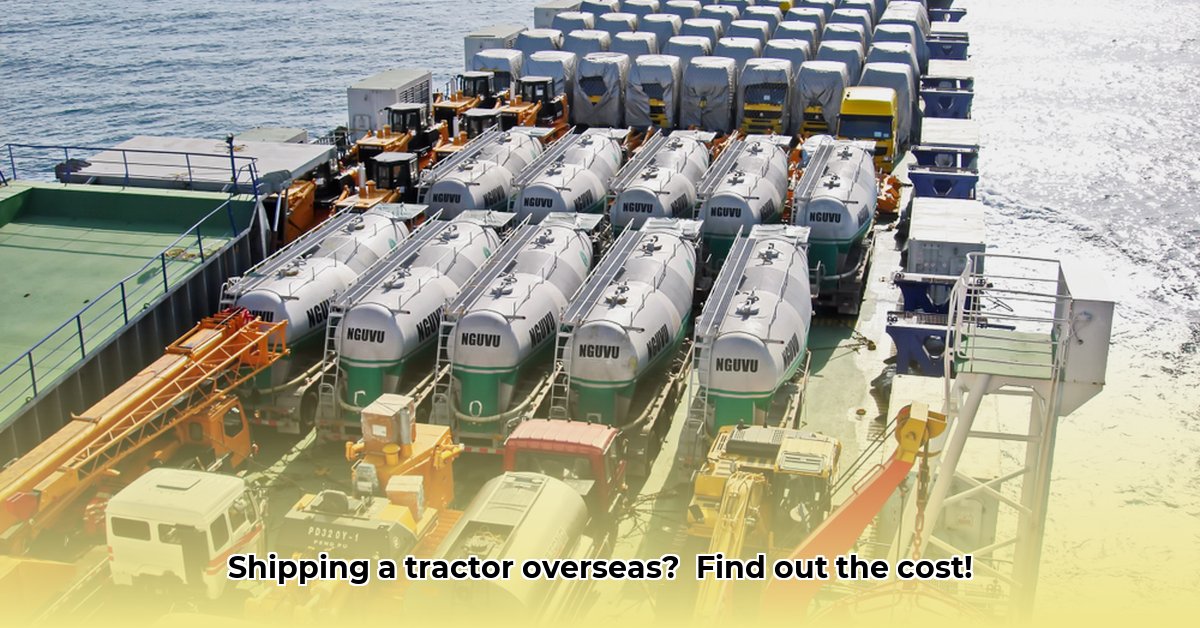
Shipping a tractor overseas is a complex undertaking. The cost isn't a simple figure; it's a multifaceted equation influenced by numerous factors. For reference on weight, see this guide on tractor trailer weights. This comprehensive guide breaks down the process, providing a step-by-step approach to calculating the total cost and ensuring a smooth, efficient international shipment. We’ll explore various shipping methods, highlighting their pros, cons, and cost implications, while offering practical advice to avoid unexpected expenses.
Factors Affecting Shipping Costs
Several key factors influence the final cost of shipping your tractor internationally. Understanding these elements is crucial for accurate budgeting and informed decision-making.
Tractor Size and Weight
The dimensions and weight of your tractor are fundamental cost drivers. A larger, heavier tractor occupies more space and requires more resources to transport, resulting in higher shipping charges. For example, a compact tractor might weigh 2,000 lbs, while a large agricultural tractor might weigh 15,000 lbs or more—a significant difference in shipping cost.
Shipping Method
Three primary methods exist, each with distinct advantages and disadvantages:
Roll-on/Roll-off (RORO): This method involves driving the tractor directly onto a cargo ship. It's generally the most economical option, especially for larger tractors. However, it offers less protection than other methods.
Container Shipping: Your tractor is secured inside a steel container, offering superior protection from the elements and potential damage during transit. This enhanced security comes at a higher cost compared to RORO.
Air Freight: The fastest but most expensive method. It's reserved for urgent shipments where time is paramount, and cost is a secondary concern.
A comparison table clarifies these differences:
| Shipping Method | Cost | Speed | Protection | Pros | Cons |
|---|---|---|---|---|---|
| RORO | Low to Moderate | Moderate | Moderate | Economical, efficient for large tractors | Less protection than container shipping |
| Container | Moderate to High | Moderate | High | Excellent protection against damage and weather | More expensive than RORO |
| Air Freight | High | High | High | Fastest transit time | Most expensive option |
Distance
The distance between the origin and destination ports directly impacts the cost. Longer distances translate to increased fuel consumption and transit time, driving up the overall expense. A shipment across the Atlantic will naturally cost more than one across a smaller sea.
Origin and Destination Ports
Port infrastructure and efficiency play a critical role. Major, well-equipped ports generally have lower handling fees and faster processing times compared to smaller, less-developed ports. Port congestion can also lead to delays and increased costs. Do your research on the efficiency of the ports involved.
Insurance
Protecting your valuable investment is paramount. Insurance costs vary depending on the tractor's value, the type of coverage (comprehensive vs. basic), and the chosen shipping method. Adequate insurance protects against loss or damage during transit. The cost is usually a percentage of the tractor's value. Don't skimp on this; it's a vital safeguard.
Customs and Duties
Import taxes and duties vary significantly by country. These fees are levied upon arrival at the destination port and can be a substantial portion of the overall cost. Thorough research into the destination country's import regulations is essential to determine these expenses. Unexpected customs charges can make or break your budget.
Domestic Transportation
Don't overlook the costs of transporting your tractor to the port of origin and from the destination port to its final location. These "land legs" of the journey add to the overall expense, especially if significant distances are involved. It's often overlooked, but adds up quickly.
Step-by-Step Guide to Shipping a Tractor
This structured approach simplifies the process:
1. Research and Quote Acquisition: Obtain quotes from multiple reputable international freight forwarders. Compare their services, pricing, and insurance options meticulously, ensuring transparency in their pricing structures. Don't hesitate to ask for clarification on any unclear items.
2. Choosing the Right Shipping Method: Based on your budget, timeframe, and the tractor's value, select the optimal shipping method. The decision-making process should involve careful consideration of the pros and cons of each option, as outlined in the previous section.
3. Insurance and Documentation: Secure adequate insurance and gather all necessary documentation. This typically includes commercial invoices, packing lists, bills of lading, certificates of origin, and any export permits required by both the origin and destination countries. This step is crucial for smooth customs clearance and avoiding delays.
4. Customs Clearance: Engage a customs broker specializing in international agricultural equipment shipments. Their expertise will streamline the clearance process, minimizing delays and avoiding potential penalties.
5. Tracking and Delivery: Monitor your tractor's progress throughout its journey using the tracking number provided by your freight forwarder. Regular communication ensures proactive problem-solving and timely delivery.
Case Study: A Sample Cost Calculation
Shipping a mid-sized tractor (approx. 8,000 lbs) from the US to Australia via container shipping might cost:
- Ocean Freight: $6,000 - $10,000
- Insurance: $500 - $1,000
- Customs Duties & Taxes (Australia): $1,000 - $3,000 (highly variable)
- Domestic Transportation (US & Australia): $1,000 - $2,000
Total Estimated Cost: $8,500 - $16,000 (This is an estimate only. Actual costs vary considerably.)
Conclusion: Planning for Success
Shipping a tractor overseas requires careful planning and a clear understanding of associated costs. By meticulously considering the factors outlined, obtaining multiple quotes, and engaging professionals for customs clearance, you can significantly improve the efficiency and cost-effectiveness of your shipment. Remember, thorough research and proactive planning are key to a successful outcome.
Resources
While specific recommendations for freight forwarders and customs brokers are beyond the scope of this general guide, your online search for "international freight forwarders" and "customs brokers [destination country]" will yield a wealth of options. Always verify their credentials and read reviews before engaging their services.